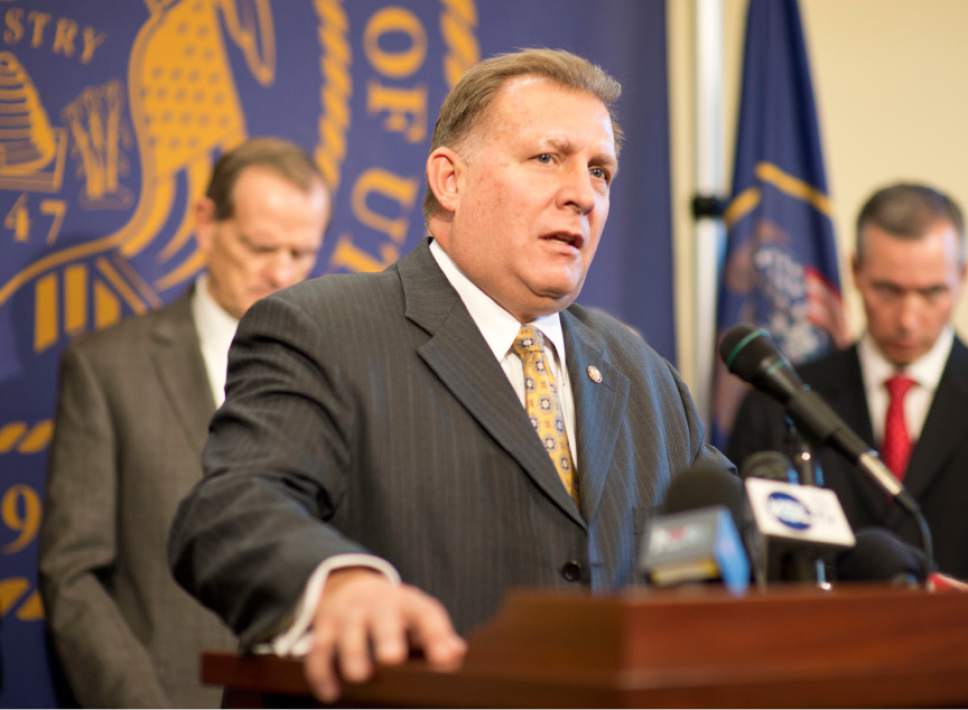This is an archived article that was published on sltrib.com in 2017, and information in the article may be outdated. It is provided only for personal research purposes and may not be reprinted.
Amid reports that President-elect Donald Trump may appoint Rep. Chris Stewart, R-Utah, as the new Air Force secretary, Utah officials are finding that the state has some big holes in its election law on how to replace him or any other member.
For U.S. House members who resign, Utah law says simply that "the governor shall issue a proclamation calling an election to fill the vacancy."
It is silent on whether that should allow conventions or primary elections first to narrow the field, how quickly the election should be held, and how candidates qualify for the ballot — including whether they could do so by gathering signatures.
Sen. Curt Bramble, R-Provo, says that leaves open the possibility of what some call a jungle election to choose a new member of Congress.
"You could have a significant number of candidates, with just one election that is winner-take-all," he said. "If you have 20 candidates, presumably someone could win the election with less than 10 percent" of the vote.
Some other unusual things could happen. For example, if numerous Republicans run while only one Democrat files, a split GOP vote might allow the Democrat to slip into office in a strongly Republican-leaning district.
Worries about the prospect of a small-plurality winner come as the Utah Republican Party has complained in recent years — and sued, so far unsuccessfully — about such a possibility in primaries created by a change in Utah election law.
In the past, Utah primaries were between just the top two candidates chosen by a party convention. With the recent change, candidates may also qualify for a primary by collecting enough signatures — creating the possibility of many candidates in the primary, and a small-plurality victor.
Bramble said legislators are looking at how to address party concerns about small-plurality winners. But it is looking to move much more quickly on figuring out how to handle a congressional replacement election, with an eye on the possibility of Stewart's departure. The Legislature convenes Jan. 23.
The topic was discussed during a GOP Senate caucus Wednesday, and Bramble afterward opened a bill file to draft legislation about it.
A first step, he said, is to develop a few different scenarios on how to hold an election, and allow legislators and others to discuss them.
"We could piggyback on existing election law, complete with primaries and conventions. That would take a longer period," he said. "Given the challenges that our nation faces, it would leave that district unrepresented during the process."
Or the state could look at a more streamlined process, perhaps including skipping primaries.
"Each [option] would have their detractors and advocates," Bramble said. "Where we are at now is looking to formulate a couple of different concepts, get them solidified in terms of timelines and pros and cons, and bring that back" for debate.
"It's something that needs to be discussed," said Mark Thomas, state elections director for Lt. Gov. Spencer Cox, who oversees Utah elections. "That section of the code is more than 100 years old…. So it's probably something that we need the Legislature to weigh in on."
He notes that the U.S. Constitution requires that midterm U.S. House vacancies be filled through an election. But for vacancies in the U.S. Senate, the Constitution allows governors to appoint replacements who serve until the next general election.
If state lawmakers don't pass any legislation on the matter, it may simply be up to Gov. Gary Herbert to decide how to handle such an election, Thomas said.
"Right now [Utah law] says the governor makes a proclamation calling an election. So the governor basically would be outlining procedures on how that election would move forward," Thomas said. "So it would be up to his discretion how that would play out."
Utah has replaced a U.S. representative at midterm only once — 88 years ago. That occurred after former Rep. Elmer O. Leatherwood, R-Utah, died in office on Dec. 24, 1929, at age 57.
His seat remained vacant for more than 10 months. The state at that time chose to go through its normal caucus-convention system, which chose party nominees both for a special election to fill Leatherwood's term and the next full term. Voters cast ballots for both on the same day during the general election of 1930.
Republican Frederick C. Loofbourow was elected both to serve the last couple months of Leatherwood's term and his own two-year term, taking office immediately after the Nov. 4, 1930, election. Newspaper archives show he won the GOP nomination by winning sufficient votes at the state Republican convention against two other candidates.
Loofbourow, one of relatively few early Utah Congress members who was not a Mormon, served only a bit more than one term. He was defeated during the Franklin D. Roosevelt-led Democratic landslide in 1932 as the Great Depression deepened.
Twitter: @LeeHDavidson







